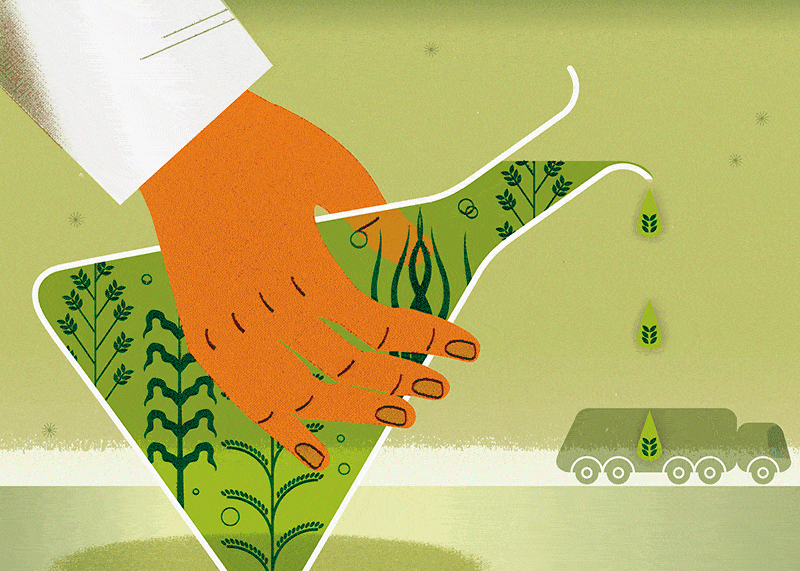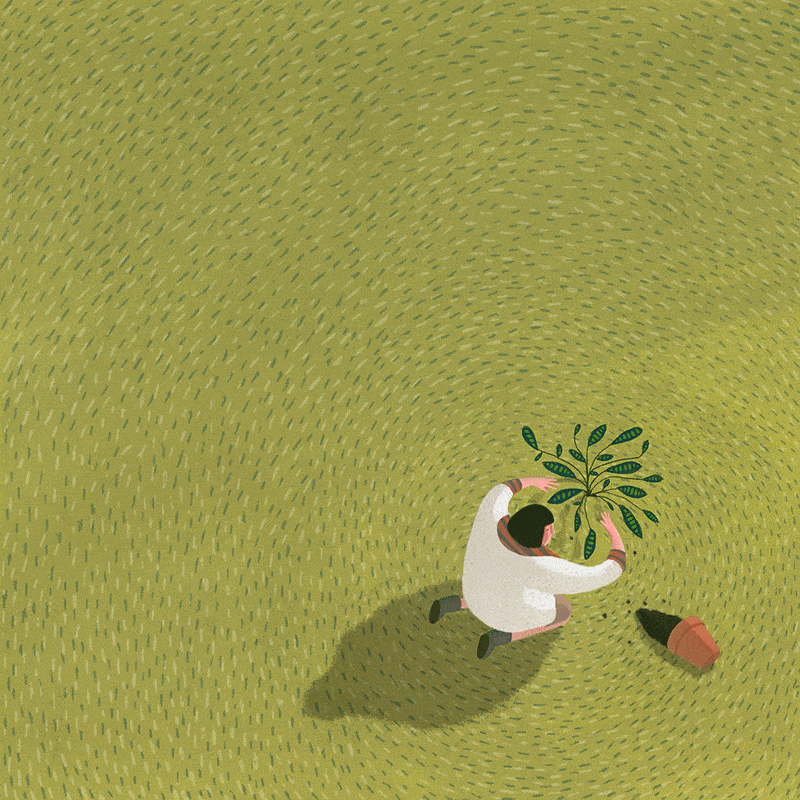Mangroves in Kuwait
Leadership of the Kuwait Institute for Scientific Research in Aquaculture and Sustainability

Dr. Laila Al-Mulla
Research Associate, Kuwait Institute for Scientific Research
Clay soils constitute about 57% of Kuwait's coastline, which is about 2,900 kilometers long, and it is an area rich in plants and halophytes, and represents an integrated ecosystem full of plant and animal wildlife, which requires intensifying greening projects in the coastal environment and developing it to maintain the stability of the ecosystem in it. Hence the idea of mangrove cultivation in the coastal area, as it is considered a natural environment for the growth of Mangrove plant globally, and this has been included in research projects for greening and beautification by the Kuwait Institute for Scientific Research for more than 26 years, and conducting the necessary studies to determine the possibility of cultivating it in the mud coasts of the country.
Mangroves are found in the Arabian Gulf region in Saudi Arabia, Qatar, the UAE, Bahrain and Oman. These countries have protection programs for the clay coasts of this plant, as well as agricultural projects to propagate it and include it in the greening and design projects of these countries. It is believed that the mangrove tree used to cover some of Kuwait's muddy coasts, but it became extinct due to uprooting it to be used as fuel and raw materials for building houses a long time ago, as it relied on burning trees and plants to produce energy, and it also relied on its fibers and wood to make building supports for simple housing at that time, according to what was circulating quoting historians and those who witnessed Kuwait in the last century. However, there is no documented scientific observation of any fungal species in Kuwait.
Therefore, the Institute conducted the first successful study of the introduction of mangroves to some sites in the muddy coasts of the State of Kuwait in 1992. This experience had a positive impact on the marine environment, as the accumulation of nutritious and beneficial sediments for marine life increased, stimulating their breeding and attracting some species of migratory birds.
The Institute has been a pioneer in conducting mangrove studies in Kuwait since the nineties, where it carried out a number of studies for the propagation and cultivation of mangroves in the coast of Kuwait. The results obtained heralded a remarkable success that enhances the possibility of introducing this tree to Kuwait's muddy coastline, and a full survey of the muddy beaches in the country was conducted. It is known that mangroves cannot be cultivated in all types of soil, so the appropriate conditions for its growth must be available, so the sites were chosen on the basis of the availability of appropriate specifications, namely: water temperature, air, water quality and purity, in addition to soil specifications: such as pH, salinity, size of soil grains, and other environmental factors. Furthermore, the site must be protected from grazing animals, free from waste, rocks, pollutants, oil stains and sewage, and know the limits of the acceptable salinity rate of the variety. Tidal waters also have to cover the site of the Mangrove plant for hours during the day to be exposed again during the carrot hours per day.
The institute brought different types of mangrove seeds and seedlings from several countries and studied them, and conducted the necessary treatments for the Qurum seeds brought for germination, so they were adapted to withstand the climatic conditions of Kuwait, and then transported and planted in the field where the selected sites are located, including Shuwaikh, Subiya, Doha and Sulaibikhat. Different seedlings of different type and source varied in their performance, and the results proved that the Avicennia Marina type imported from the Arabian Gulf Sea is the best tolerant species adapted to the environmental and climatic conditions of Kuwait.
Surveys were carried out to select additional sites suitable for the expansion of mangrove cultivation and its use in greening projects in the country. The Institute and the Regional Organization for the Protection of the Marine Environment (ROPME) have developed recommendations not to introduce invasive species of mangrove from species found on the coasts of the Arabian Gulf, so as not to cause a negative impact on the fungal species circulating in the region.
The Institute's projects in mangrove cultivation have been sporadic
studies between 1992 and 1996 involving soil study, sourcing and bringing in different varieties of mangrove plant seeds. It was the first successful experiment in the State of Kuwait in the cultivation of mangroves on the muddy coasts in the State of Kuwait.
The project (Mangrove Farming for the Protection and Enrichment of Kuwaiti Coasts – Phase I), which ranged from 1996 to 1999, aimed at determining the biological feasibility of mangrove cultivation, identifying factors affecting the establishment of its farms, and evaluating and providing data on mangrove growth along mudflats in Kuwait. The results of this research showed that the breeds coming from the United Arab Emirates and the Kingdom of Bahrain are suitable for the successful establishment of Mangrove communities (A. marina) on the mudflats of Kuwait between the two tidal zones. This result was very important as it was the first time that Kuwait succeeded in introducing mangroves on the coasts and establishing them locally, in addition to choosing the appropriate varieties for the country. The study showed the importance of these crops in enriching the biological stock.
The project (Mangrove cultivation for the protection and enrichment of the Kuwaiti coasts - Phase II), which ranged from January 1999 to December 2001, aimed at standardizing vegetative propagation and agricultural practices for mangrove cultivation in light of the harsh climatic conditions of Kuwait and assessing the environmental impact of mangrove farming on the coastal strip. Five pilot farms were established and the technology for planting grey mangroves (A. marina) was standardized in Shuwaikh, Subiya, Doha and Sulaibikhat. This project was partially funded by the Kuwait Foundation for the Advancement of Sciences (KFAS) and in cooperation with the Public Authority for Agriculture Affairs and Fish Resources.
Project (Mangrove Planting on the Coastal Strip – Phase I), which ranged between October 2011 and May 2012, with the aim of conducting a field survey of the area concerned for the work of the project, assessing the condition of mangrove trees in this area, selecting appropriate sites for planting mangroves on Kuwait Bay and the Subiya area, and studying different treatments, to try to propagate the mangrove plant, and identify sources to bring seedlings and seeds of mangroves.
The project (Mangrove Planting on the Coastal Strip – Phase II), which was between March 2016 and August 2018, and one of its most important objectives was to develop an effective technique for the production of mangrove seedlings under the climatic conditions of Kuwait, and to conduct a comprehensive assessment of the site to develop an action plan for environmental rehabilitation by planting mangroves under the climatic conditions of the country, and to start developing a long-term monitoring plan after planting mangroves to know the changes in the characteristics of the soil and sea water, and to conduct a study to assess the environmental impact when Start planting Mangrove.
Environmental
impact studies Environmental impact studies conducted between 2001 and 2018 showed that the mangrove plant does not threaten the existence of any other plant on the coasts of Kuwait, as it is not considered a competitor to the fungal plants found in these coasts, on the contrary, the presence of mangroves stimulates the accumulation of sediments rich in nutrients useful for plant growth, which in turn complements the food pyramid of the coastal ecosystem to make it more stable and balanced. The spread of mangrove cultivation is a successful and guaranteed opportunity in greening and beautification projects, and the environmental impact assessment after planting mangroves on the coasts proved the ability of this tree to increase biodiversity and promote increased fish and shrimp production in Kuwait, by helping it to collect sediments and nutrients, and act as incubators for many marine life, and attract a large and diverse number of birds, in addition to increasing vegetation cover on the coasts. These trees contribute to the enrichment of coasts and marine waters and increase their productivity, and are expected to contribute to improving the quality of marine waters in addition to the high rate of reproduction and increase of coastal and marine organisms, leading to the rehabilitation of damaged environments.
Observation studies conducted by the Institute have shown a deterioration in the vegetation cover of mangroves in some cultivated sites in the above-mentioned areas over the past three years. This is due to a set of environmental and climatic factors, the most important of which are: the receding tide water due to the sediments resulting from the construction and construction works carried out to build the bridge crossing the Kuwait Bay, and the development projects of the Sulaibikhat coast, which led to the inability of tide water to reach the trees and flood them during the hours of the day from the tide stage, in addition to the high temperatures and drought during the day in the summer, and the low level of humidity, which led to the burning and drying of the upper layer of trees, and the loss of Flowers before their maturity to form seeds.
The institute is still conducting several studies to propagate mangrove seedlings, innovating advanced methods of growing them on clay coasts, and is working to expand the selection of sites to overcome the problem of seedling loss. This expansion requires support from the state by providing new sites, so that the institute proposes them and supervises their cultivation after conducting appropriate surveys to avoid losses, reduce the loss of seedlings and preserve state resources in support of this project.
Publications on Mangroves The Institute
was the first to organize an international conference in the State of Kuwait on Qurum in April 1998 under the title: The International Symposium on Mangrove Ecology and Biology in order to provide a mutual knowledge base and global experiences that contribute to the establishment of mangrove farms. Similar projects have been used regionally and globally to be studied in local climates.
The Institute has prepared booklets on mangrove cultivation in Kuwait in order to enrich the coastline. These publications provided the special protocol for its cultivation in terms of selection of suitable sites, varieties and sources, method of seed germination, seedling production, hardening and cultivation in the field, acclimatization to seawater, monitoring their growth, and precautions to improve their growth on the Kuwaiti coast. The Institute has also published many scientific articles in refereed journals on Kuwait's experience in this field.




